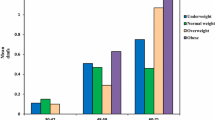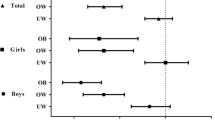Abstract
The aim of the present study was to investigate the association between caries frequency and body mass index (BMI) in German elementary school children. A total of 1,290 elementary school children (648 boys, 642 girls) were examined. The dental examination included the determination of caries frequency (DF-T/df-t values). The medical evaluation assessed the pupils’ general health and BMI. The study showed that 3.6% of the children were underweight, 74.8% had a normal weight, 11.9% were overweight, and 9.7% were obese. Underweight children showed natural healthy teeth in 44.7%, those with normal weight in 40.7%, whereas children with high weight and obese children showed natural healthy teeth in 30.5% and 31.7%, respectively. A significant association between high weight and caries frequency in the first dentition (p = 0.0067) and in the permanent dentition (p = 0.0002) could be observed. The association remains statistically significant after adjusting for age. The number of natural healthy teeth decreased with age (p = 0.001) and BMI (p = 0.0061) and was different between girls and boys (p = 0.0334). This study demonstrated a significant association between caries frequency and weight in school children. In future preventive programs, the importance of nutrition should not only be emphasized with respect to general diseases but also with regard to carious lesions.



Similar content being viewed by others
References
Arbeitsgemeinschaft Adipositas im Kindes-und Jugendalter der Deutschen Adipositas Gesellschaft, Leitlinien vom 04.10.2002
Chen W, Chen P, Chen SC, Shih WT, Hu HC (1998) Lack of association between obesity and dental caries in three-year old children. Zhonghua Minguo Xiaoer Keyi Xuehui Zazhi 38:109–111
Danielzik S, Langnäse K, Mast M, Spetmann C, Müller MJ (2002) Impact of parental BMI on the manifestation of overweight 5–7 year old children. Eur J Nutr 41:132–138
De Spiegelaere M, Dramaix M, Hennert P (1998) The influence of socioeconomic status on the incidence and evolution of obesity during early adolescence. Int J Obes 22:268–274
Dietz WH, Robinson TN (1998) Use of the body mass index (BMI) as a measure of overweight in children and adolescents. J Pediatr 132:191–193
Fiscella K (1999) Is lower income associated with greater biopsychosocial morbidity? Implications for physicians working with underserved patients. J Fam Pract 48:372–377
Flegal KM, Troiano RP (2000) Changes in the distribution of body mass index of adults and children in the US population. Int J Obes Relat Metab Disord 24:807–818
Fontaine KR, Bartlett SJ (2000) Access and use of medical care among obese persons. Obes Res 8:403–406
Freedman DS, Khan LK, Dietz WH, Srinivasan SR, Berebson GS (2001) Relationship of childhood obesity to coronary heart disease risk factors in adulthood: the Bogalusa heart Study. Pediatrics 108:712–718
Hollister MC, Weintraub JA (1993) The association of oral status with systemic health, quality of life, and economic productivity. J Dent Educ 57:901–911
Heude B, Lafay L, Borys JM (2003) Time trend in high, weight, and obesity prevalence in school children from Northern France, 1992–2000. Diabetes Metab 29:235–240
Janssen IJ, Craig WM, Boyce WF, Pickett W (2004) Associations between overweight and obesity with bullying behaviours in school-aged children. Pediatrics 113:1187–1194
Kalies H, Lenz J, von Kries R (2002) Prevalence of overweight and obesity and trends in body mass index in German pre-school children, 1982–1997. Int J Obes Relat Metab Disord 26:1211–1217
Klein H, Palmer CE, Knutson JW (1938) Studies in dental caries. I. Dental status and dental needs of elementary school children. Public Health Rep 53:751
Klumbiene J, Petkeviciene J, Heasoja V, Prättäla R, Kasmel A (2004) Sociodemographic and health behaviour factors associated with obesity in adult populations in Estonia, Finland and Lithuania. Eur J Public Health 14:390–394
Kromeyer-Hauschild Jaeger U (1998) Growth studies in Jena, Germany: changes in body size and subcutaneous fat distribution between 1975 and 1995. Am J Human Biol 10:579–587
Locker D (1988) Measuring oral health: a conceptual framework. Community Dent Health 5:3–18
Marcenes W, Steele JG, Sheiham A, Walls AWG (2003) The relationship between dental status, food selection, nutrient intake, nutritional status, and body mass index in older people. Cad Saúde Pública, Rio de Janeiro 19:809–916
Mokdad AH, Ford ES, Bowman BA (2003) Prevalence of obesity, diabetes, and obesity-related health risk factors. JAMA 289:76–79
Ogden CL, Flegal KM, Carroll MD, Johnson CL (2002) Prevalence and trends in overweight among US children and adolescents 1999–2000. JAMA 288:1728–1732
Pearce MJ, Boergers J, Prinstein MJ (2002) Adolescent obesity, overt and relational peer victimization, and romantic relationships. Obes Res 10:386–393
Pieper K (2005) Epidemiologische Begleituntersuchung zur Gruppenprophylaxe 2004. Dtsch Arbeitsgemeinschaft für Jugendzahnpflege e. V, Bonn
Reisine ST, Locker D (1995) Social, psychological and economic impacts of oral conditions and treatments. In: Cohen LK, Gift HC (eds) Disease prevention and oral health promotion. Socio-dental sciences in action. Munksgaard, Copenhagen, pp 33–71
Sinha R, Fisch G, Teague B (2002) Prevalence of impaired glucose tolerance among children and adolescents with marked obesity. N Engl J Med 246:802–810
Tremblay MS, Katzmarzyk PT, Willms JD (2002) Temporal trends in overweight and obesity in Canada, 1981–1996. Int J Obes Relat Metab Disord 26:538–543
Troiano RP, Flegal KM, Kuczmarski RJ, Campbell SM, Johnson CL (1995) Overweight prevalence and trends for children and adolescents: the National Health and Nutrition Examination Surveys, 1963–1991. Arch Pediatr Adolesc Med 149:1085–1901
Turrell G, Western JS, Najman JM (1994) The measurement of social class in health research: problems and prospects. In: Waddell C, Petersen AR (eds) Just health: inequality in illness, care and prevention. Churchill Livingstone, Melbourne, pp 87–103
Twetman S, Garcia-Godoy F, Goepferd SJ (2000) Infant oral health. Dent Clin North Am 44:487
Wang Z, Patterson CM, Hills AP (2002) Association between overweight or obesity and household income and parental body mass index in Australian youth. Analysis of the Australian National Nutrition Survey, 1995. Asia Pac J Clin Nutr 11:200–205
Whitaker R, Wright JA, Pape MS, Seidel KD, Dietz WH (1997) Predicting obesity in young adulthood from childhood and parental obesity. N Engl J Med 337:869–873
WHO (2000) Obesity-preventing and managing the global epidemic. Report of a WHO consulting on obesity. WHO Technical Report Series 894
Zayat EN, Fontaine KR, Cheskin LJ (1999) Use of preventive health care services by patients with obesity. Obes Res 7:223–226
Author information
Authors and Affiliations
Corresponding author
Rights and permissions
About this article
Cite this article
Willerhausen, B., Blettner, M., Kasaj, A. et al. Association between body mass index and dental health in 1,290 children of elementary schools in a German city. Clin Oral Invest 11, 195–200 (2007). https://doi.org/10.1007/s00784-007-0103-6
Received:
Accepted:
Published:
Issue Date:
DOI: https://doi.org/10.1007/s00784-007-0103-6




